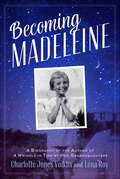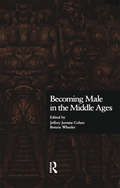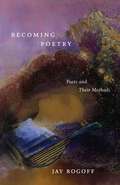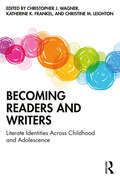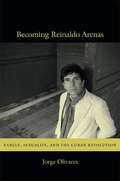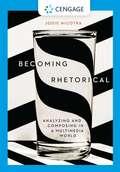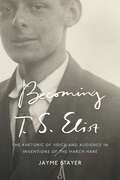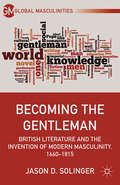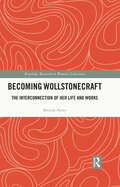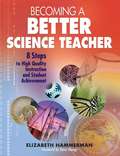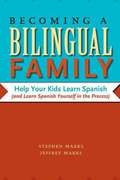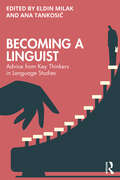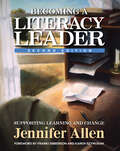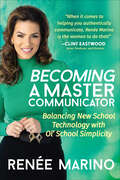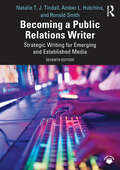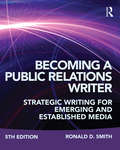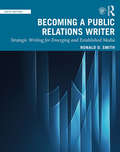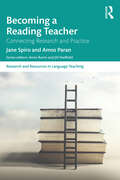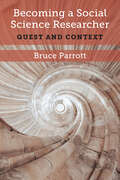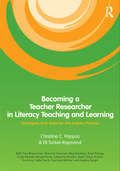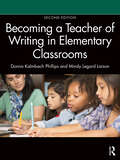- Table View
- List View
Becoming Madeleine: A Biography of the Author of A Wrinkle in Time by Her Granddaughters
by Charlotte Jones Voiklis Léna RoyThis middle-grade biography explores the life and works of Madeleine L'Engle —written by her granddaughters.This elegant and insightful biography of Madeleine L’Engle (1918–2007) was written by her granddaughters, Charlotte Jones Voiklis and Léna Roy. Using never-before-seen archival materials that include photographs, poems, letters, and journal entries from when Madeleine was a child until just after the publication of her classic, A Wrinkle in Time, her granddaughters weave together an in-depth and unique view of the famous writer. It is a story of overcoming obstacles—a lonely childhood, financial insecurity, and countless rejections of her writing—and eventual triumph. Becoming Madeleine will speak not only to fans of the icon’s work, but also to anyone interested in writing.This title has Common Core connections.
Becoming Male in the Middle Ages (New Middle Ages #No. 4)
by Jeffrey Jerome Cohen Bonnie WheelerFirst published in 2000. Routledge is an imprint of Taylor & Francis, an informa company.
Becoming Modern Women
by Michiko SuzukiSuzuki (East Asian Languages and Cultures, Indiana University) looks at the works of three pre-war Japanese women writers in order to investigate the role of love in Japanese culture during the first half of the 20th century. The author interprets women's fiction along with with nonfiction from a range of media, including early feminist writing, sexology books, newspapers, and bestselling love treatises, showing how the concept of "woman" was constructed through the modern experience of love. Suzuki also explores the historical and ideological shifts of the period, underscoring the broader connections between gender, modernity, and nationhood. Annotation ©2010 Book News, Inc. , Portland, OR (booknews. com)
Becoming Poetry: Poets and Their Methods
by Jay RogoffWinner of the Lewis P. Simpson AwardIn Becoming Poetry, Jay Rogoff closely inspects the work of two dozen poets, his forebears and his contemporaries, to reveal how their poetry achieves its impact upon readers. His essays, drawn from more than twenty years of literary criticism, explore how the staying power of a poet’s work and the likelihood of its enjoying a lasting identification with its creator depend on the skilled manipulation of poetic technique. Considering how poetry can manifest a vividly conceived world of feeling and sensation, Rogoff maintains that we understand and evaluate poets by the sum of their most persuasive inventive strategies, including their attention to form. The poet, finally, constructs a uniquely imagined universe and thus, in the minds of readers, becomes the poetry.A model of practical criticism, intended for enthusiasts at all levels, Becoming Poetry demystifies how poetry operates on its audience to create a virtual, affective experience of lasting power and value.
Becoming Readers and Writers: Literate Identities Across Childhood and Adolescence
by Christopher J. Wagner Katherine K. Frankel Christine M. LeightonCentered around the idea that literacy teaching is more than the transmission of strategies and skills, this volume serves as a foundation for approaching literacy from an identity perspective. Through incisive and accessible chapters from top scholars, it introduces readers to the concept of literate identities, examining them across ages and grade levels to present an overview of how scholars and educators can use this concept in their research and teaching. Organized by developmental level with sections on early childhood, middle childhood, adolescence, and cross-age research, contributors reveal how literacy can be framed as an identity practice to engage students and support their development. Applying a range of theoretical perspectives and frameworks, each chapter identifies the identity theory used, explains the relevant methodology and research questions, covers implications for practice, and includes questions or prompts for discussion. The volume reveals how understanding literate identities is at the heart of effective and inclusive literacy instruction by addressing key topics, including culturally relevant pedagogy, intersectionality, and transnationalism, among others. Illuminating multiple pathways to understanding students as readers and writers, this book is essential for teachers, scholars, and researchers in literacy education, research methods, and multicultural education.
Becoming Reinaldo Arenas: Family, Sexuality, and the Cuban Revolution
by Jorge OlivaresBecoming Reinaldo Arenas explores the life and work of the Cuban writer Reinaldo Arenas (1943-1990), who emerged on the Latin American cultural scene in the 1960s and quickly achieved literary fame. Yet as a political dissident and an openly gay man, Arenas also experienced discrimination and persecution; he produced much of his work amid political controversy and precarious living conditions. In 1980, having survived ostracism and incarceration in Cuba, he arrived in the United States during the Mariel boatlift. Ten years later, after struggling with poverty and AIDS in New York, Arenas committed suicide. Through insightful close readings of a selection of Arenas's works, including unpublished manuscripts and correspondence, Olivares examines the writer's personal, political, and artistic trajectory, focusing on his portrayals of family, sexuality, exile, and nostalgia. He documents Arenas's critical engagement with cultural and political developments in revolutionary Cuba and investigates the ways in which Arenas challenged literary and national norms. Olivares's analysis shows how Arenas drew on his life experiences to offer revealing perspectives on the Cuban Revolution, the struggles of Cuban exiles, and the politics of sexuality.
Becoming Rhetorical: Analyzing And Composing In A Multimedia World
by Jodie NicotraBecoming rhetorical is a transformation that allows students to identify rhetorical problems and respond to them with arguments, no matter the course or context from which the problems emerge. In BECOMING RHETORICAL, author Jodie Nicotra takes students beyond the view of the rhetorical situation as being composed of communicator, audience, and message, encouraging them also to consider important aspects such as exigence, purpose, and the means of communication. Students learn to analyze and compose in textual, visual, and multimodalities -- from evaluating an op-ed piece, to making a video of a consumer product, to creating an entire public awareness campaign -- thereby becoming confident critical thinkers in a 21st century multimedia world.
Becoming T. S. Eliot: The Rhetoric of Voice and Audience in Inventions of the March Hare
by Jayme StayerHow did an ordinary, if intelligent, boy who wrote unremarkable poems become—with no help, and in record time—the author of one of the most significant and beloved poems of the twentieth century?T. S. Eliot's juvenilia show little inclination to question the social, cultural, religious, or domestic values he had inherited. How did a young man who wrote uninspired doggerel about wilting flowers transform himself—in a mere twenty months—into the author of "The Love Song of J. Alfred Prufrock"? In Becoming T. S. Eliot, Jayme Stayer—praised by Christopher Ricks as a scholar who is "scrupulous in acknowledging the contingencies that will always preclude perfection"—explains this staggering accomplishment by tracing Eliot's artistic and intellectual development. Relying on archival research and original analysis, this is the first book dedicated entirely to Inventions of the March Hare, Eliot's youthful notebook, which was once thought lost but was rediscovered after Eliot's death. Stayer places Eliot's verses in the chronological order of their composition, teasing out the narratives of their making. Focusing on the period from 1909 to 1915, this incisive portrait of Eliot as a budding writer is as much a study of Eliot himself as it is a study of how a writer hones his voice.
Becoming The Gentleman: British Literature and the Invention of Modern Masculinity, 1660–1815 (Global Masculinities)
by Jason D. SolingerBecoming the Gentleman explains why British citizens in the long eighteenth century were haunted by the question of what it meant to be a gentleman. Supplementing recent work on femininity, Solinger identifies a corpus of texts that address masculinity and challenges the notion of a masculine figure that has been regarded as unchanging.
Becoming Wollstonecraft: The Interconnection of Her Life and Works (Routledge Research in Women's Literature)
by Brenda AyresBecoming Wollstonecraft: The Interconnection of Her Life and Works draws from biography to explain her works, and it analyses the works to draw a biographical composite of Wollstonecraft. Becoming Wollstonecraft will be more fully developed than previous works, with added information that has not previously been associated with Wollstonecraft, such as the story of Reverend Mr. Joshua Waterhouse.Although there are over fifty book-length biographies published on Wollstonecraft, very few agree on much about Wollstonecraft. She seems to have become an “everywoman,” or a figure unfixed in time and protean. Deemed the Mother of Feminism, like feminism itself, she is what people have wanted her to be and is by no means an immutable or universal personage.A study of her life as evident by her works and vice versa, this monograph intends to refocus the image of Wollstonecraft for students and scholars, informed by biographical texts on Wollstonecraft and on those people in Wollstonecraft’s life and acquaintance, historical context, and exposition from her works.
Becoming a Better Science Teacher: 8 Steps to High Quality Instruction and Student Achievement
by Elizabeth Hammerman Dave YoungsIn today’s standards-based educational climate, teachers are challenged to create meaningful learning experiences while meeting specific goals and accountability targets. In her essential new book, Elizabeth Hammerman brings more than 20 years as a science educator and consultant to help teachers connect all of the critical elements of first-rate curriculum and instruction.With this simple, straight-on guide, teachers can analyze their existing curriculum and instruction against a rubric of indicators of critical characteristics, related standards, concept development, and teaching strategies to develop students’ scientific literacy at the highest levels. Every chapter is packed with charts, sample lesson ideas, reflection and discussion prompts, and more, to help teachers expand their capacity for success.Hammerman describes what exceptional teaching looks like in the classroom and provides practical, teacher-friendly strategies to make it happen. This research-based resource will help teachers: Reinforce understanding of standards-based concepts and inquiry Add new content, methods, and strategies for instruction and assessment Create rich learning environments Maximize instructional time Ask probing questions and sharpen discussion Include technology Gather classroom evidence of student achievement to inform instructionThrough a new, clear vision for high quality science teaching, this book gives teachers everything they need to deliver meaningful science instruction and ensure student success and achievement.
Becoming a Bilingual Family: Help Your Kids Learn Spanish (and Learn Spanish Yourself in the Process)
by Jeffrey Marks Stephen MarksWould you like your children to grow up bilingual, even if you aren't yet? Then speak to your kids in Spanish as you learn the language along with them. Becoming a Bilingual Family gives English-speaking parents the tools to start speaking Spanish with their kids in their earliest years, when children are most receptive to learning languages. It teaches the vocabulary and idioms for speaking to children in Spanish and offers practical, proven ways to create a language-learning environment at home. The first part of the book introduces parents to many resources--books, audio books, music, television, computer programs, childcare workers, school, and friends--that can help you establish a home environment conducive to the acquisition of Spanish. The second part is a Spanish phrasebook that takes you through all the typical activities that parents and children share, from getting up in the morning to going to bed at night. Few, if any, other Spanish study aids provide this much vocabulary and guidance for talking to small children about common daily activities. The authors also include a quick course in Spanish pronunciation and enough grammar to get a parent started. Spanish-language resources, kids' names in Spanish, and an easy-to-use index and glossary complete the book. Take the Markses' advice and start talking to your kids in Spanish, even if it's not perfect. You'll learn the language together and share the excitement of discovering the peoples and cultures that make up the Spanish-speaking world.
Becoming a Linguist: Advice from Key Thinkers in Language Studies
by Milak, Edited by EldinThis unique collection of essays, edited by and for students of linguistics, offers insights into the personal and professional journeys of some of the key thinkers in language studies.With contributions by fifteen established scholars, the volume provides first-hand insights into the ‘becoming’ of a linguist, and the many joys and challenges which come with it. The contributors pair honest and practical academic advice with personal experiences to assist novice and aspiring linguists to find their footing in the rapidly changing landscape of language studies, and guide them through linguistics past, present, and future. Autobiographical and reflexive, each chapter also includes recommendations for key readings and resources used or produced by the contributors.As a volume focused on the people behind the ideas, Becoming a Linguist will be of interest to students and scholars of language and linguistics, the history of linguistic thought, as well as the interested general reader.
Becoming a Literacy Leader: Supporting Learning and Change
by Jennifer AllenIn this second edition of Becoming a Literacy Leader: Supporting Learning and Change, author Jennifer Allen reflects on her work as a literacy specialist and how the role has evolved in the decade since she wrote the first edition. Her experiences can apply to all school leaders including principals, coaches, teachers, support staff, and office administrators. Allen focuses on three ideas to describe her work: Layered Leadership, the multitude of supports in place for teachers to encourage learning and change within schools; Shared experiences that develop community and develop common understanding of practices, curriculum, and assessment; Importance of 'rowing in the same direction' in that literacy coaches and leaders stay interconnected and aligned to the goals of the school. Allen knows the challenges of teachers face and advocates literacy coaches implement these layers of support within a school, including in-class support, curriculum support and assessment, study group facilitation, and the cultivation of teacher leadership. In Becoming a Literacy Leader, she provides an explicit framework for implementing these layers of coaching and explains how administrators can use the literacy leader position to build and sustain change within their schools. This book will be the road map for how literacy leaders and coaches approach their work with purpose and intention. Online videos that accompany the book bring the text alive by showing readers what coaching looks and sounds like.
Becoming a Master Communicator: Balancing New School Technology with Ol' School Simplicity
by Renée MarinoBecoming a Master Communicator is a practical and exciting guidebook from communication coach and Broadway actress Renée Marino. &“Renée has made it her obsession to help everyday people master communication with simple processes and tools. If you strive for higher purpose or success, then learning these principles is a must.&” —New York Times–bestselling author Dean Graziosi Renée Marino offers an essential guide for those looking to have clear and authentic communication with others by using digital technology as a tool—but not the only tool. Smartphones and computers make everyday communication incredibly convenient. However, when used as an individual&’s sole source of connection, it can make one forget real human contact and interaction are incredibly vital, thus causing unnecessary misunderstandings. Through personal stories and easily applicable practices, Renée explains how to become a master communicator in personal and professional settings by knowing when to use digital technology and when to put the devices down to have a direct conversation. Discover how to: Establish true self-confidence, fulfilling relationships, and an extraordinary career. Use simple and practical tools to strengthen your communication muscles every day. Save time, energy, and stress by getting right to the heart of a communication matter. Become a powerful leader in your professional life. Take hold of every opportunity that comes across your path. Experience more joy, gratitude, and presence each day. Claim who you want to be and the life you want to lead. Everything starts with communication, and when you can communicate confidently and honestly, you become unstoppable. That journey begins here.
Becoming a Poet in Anglo-Saxon England
by Emily V. ThornburyCombining historical, literary and linguistic evidence from Old English and Latin, Becoming a Poet in Anglo-Saxon England creates a new, more complete picture of who and what pre-Conquest English poets really were. It includes a study of Anglo-Saxon words for 'poet' and the first list of named poets in Anglo-Saxon England. Its survey of known poets identifies four social roles that poets often held - teachers, scribes, musicians and courtiers - and explores the kinds of poetry created by these individuals. The book also offers a new model for understanding the role of social groups in poets' experience: it argues that the presence or absence of a poetic community affected the work of Anglo-Saxon poets at all levels, from minute technical detail to the portrayal of character. This focus on poetic communities provides a new way to understand the intersection of history and literature in the Middle Ages.
Becoming a Public Relations Writer: Strategic Writing for Emerging and Established Media
by Natalie T. Tindall Amber L. Hutchins Ronald D. SmithThe seventh edition of Becoming a Public Relations Writer serves as an essential guide to the writing process for public relations practice. The text covers public relations writing formats across digital and traditional media, providing comprehensive examples, guidelines, and exercises to learn the fundamentals of public relations writing and help students practice their writing and editing skills. This new edition is significantly streamlined with numerous updates throughout. It features updated diverse and inclusive examples and expands its coverage of writing for digital and social media, addressing influencer relations, media pitching, and media catching. A standalone chapter on ethics and legal issues for the PR writer also informs every chapter of the text. Helpful pedagogy includes in-class discussion prompts and writing assignments. This seventh edition is an ideal text for undergraduate and postgraduate courses in public relations writing. Free additional online resources include chapter summaries, assignments, test bank, sample syllabi, and other resources for the PR writer. Please visit www.routledge.com/9781032159324.
Becoming a Public Relations Writer: Strategic Writing for Emerging and Established Media
by Ronald D. SmithBecoming a Public Relations Writer is a comprehensive guide to the writing process for public relations practice. Using straightforward, no-nonsense language, realistic examples, easy-to-follow steps, and practical exercises, this text introduces the various formats and styles of writing you will encounter as a public relations practitioner. A focus on ethical and legal issues is woven throughout, with examples and exercises addressing public relations as practiced by corporations, non-profit agencies, and other types of organizations both large and small. In addition, the book offers the most comprehensive list of public relations writing formats to be found anywhere--from the standard news release to electronic mail and other opportunities using a variety of technologies and media. The fifth edition has been updated to reflect significant developments in the public relations field, including: New and updated information on research into persuasion and social psychology aimed at helping readers be more influential in their writing. Significant updating on a new chapter on multimedia, introducing a new transmedia format for a comprehensive news package for print, broadcast, online and social media. Expansion of a chapter on websites, blogs and wikis. Expansion of the chapter on direct mail and online appeals. Updated examples of actual pieces of public relations writing. A companion website with resources for instructors and students, including a glossary, flashcards, exercises, and appendices on ethical standards, careers in public relations, and professional organizations. Through its comprehensive and accessible approach, Becoming a Public Relations Writer is an invaluable resource for future and current public relations practitioners.
Becoming a Public Relations Writer: Strategic Writing for Emerging and Established Media
by Ronald D. SmithThe sixth edition of Becoming a Public Relations Writer continues its place as an essential guide to the writing process for public relations practice. Smith provides comprehensive examples, guidelines and exercises that allow students to both learn the fundamentals of public relations writing and practice their writing skills. Ethical and legal issues are woven throughout the text, which covers public relations writing formats for both journalistic and organizational media. This new edition updates and expands its coverage of writing for digital and social media—including blogs, websites and wikis, as well as social networking (Facebook), microblogging (Twitter), photo sharing (Instagram and Snapchat) and video sharing (YouTube). This range reflects the current landscape of public relations writing, preparing undergraduate students for a public relations career. Becoming a Public Relations Writer is a trusted resource for courses in public relations, media writing and strategic communication. Previous editions of this text have been adopted by more than 190 colleges and universities in the U.S. and among other English-speaking nations. Complementary online materials are provided for both instructors and students; instructors have access to support materials such as test banks, chapter overviews and a sample syllabus, while students will benefit from career prep resources such as ethics codes, an overview of professional organizations and sample news packages. Visit the Companion Website at www.routledge.com/cw/smith.
Becoming a Reading Teacher: Connecting Research and Practice (Research and Resources in Language Teaching)
by Amos Paran Jane SpiroThis book encourages readers to think about reading not only as an encounter with written language, but as a lifelong habit of engagement with ideas. We look at reading in four different ways: as linguistic process, personal experience, collective experience, and as classroom practice. We think about how reading influences a life, how it changes over time, how we might return at different stages of life to the same reading, how we might respond differently to ideas read in an L1 and L2. There are 44 teaching activities, all founded on research that explores the nature, value and impact of reading as an authentic activity rather than for language or study purposes alone. We consider what this means for schools and classrooms, and for different kinds of learners. The final part of the book provides practical stepping stones for the teacher to become a researcher of their own classes and learners. The four parts of the book offer a virtuous join between reading, teaching and researching. It will be useful for any teacher or reader who wishes to refresh their view of how reading fits in to the development of language and the development of a reading life.
Becoming a Social Science Researcher: Quest and Context
by Bruce ParrottBecoming a Social Science Researcher is designed to help aspiring social scientists, including credentialed scholars, understand the formidable complexities of the research process. Instead of explaining specific research techniques, it concentrates on the philosophical, sociological, and psychological dimensions of social research. These dimensions have received little coverage in guides written for social science researchers, but they are arguably even more important than particular analytical techniques. Truly sophisticated social science scholarship requires that researchers understand the intellectual and social contexts in which they collect and interpret information. While social science training in US graduate schools has become more systematic over the past two decades, graduate training and published guidance still fall short in addressing this fundamental need.
Becoming a Teacher Researcher in Literacy Teaching and Learning: Strategies and Tools for the Inquiry Process
by Christine C. Pappas Eli Tucker-RaymondDesigned to facilitate teachers’ efforts to meet the actual challenges and dilemmas they face in their classrooms, Becoming a Teacher Researcher in Literacy Teaching and Learning: provides background information and key concepts in teacher research covers the "how-to" strategies of the teacher research process from the initial proposal to writing up the report as publishable or presentable work illustrates a range of literacy topics and grade levels features twelve reports by teacher researchers who have gone through the process, and their candid remarks about how activities helped (or not) helps teachers understand how knowledge is constructed socially in their classrooms so that they can create instructional communities that promote all students’ learning. Addressing the importance of teacher research for better instruction, reform, and political action, this text emphasizes strategies teachers can use to support and strengthen their voices as they dialogue with others in the educational community, so that their ideas and perspectives may have an impact on educational practice both locally in their schools and districts and more broadly.
Becoming a Teacher of Writing in Elementary Classrooms
by Donna Kalmbach Phillips Mindy Legard LarsonBecoming a Teacher of Writing in Elementary Classrooms nurtures teachers’ identities as writers, connects to the realities of writing instruction in real and diverse classrooms, and encourages critical and creative thinking. This text is about writing instruction as a journey teachers and students embark on together. The focus is on learning how to teach writing through specific teaching and learning structures found in the Writing Studio: mini-lessons; teacher and peer conferencing; guided writing; and sharing, celebrating, and broadcasting writing. Pedagogical features include teaching structures and strategies, "Problematizing Practice" classroom scenarios, assessment resources, and a Companion Website. Because a teacher who views him or herself as a writer is best positioned to implement the Writing Studio, a parallel text, Becoming-writer, give readers space to consider who they are as a writer, their personal process as a writer, and who they might become as a writer.
Becoming a Teacher of Writing in Elementary Classrooms
by Donna Kalmbach Phillips Mindy Legard LarsonThe Second Edition of Becoming a Teacher of Writing in Elementary Classrooms is an interactive learning experience focusing on all aspects of becoming-writer and teacher of writing in the Writing Studio. The Writing Studio is illustrated with authentic classroom scenarios and include descriptions of assessments, mini-lessons, mentor texts, and collaborative and individual teaching strategies. The parallel text, Becoming-Writer, allows readers to engage as writers while learning and applying writing process, practice, and craft of the Writing Studio. The new edition includes integration of preschool writers, multilingual learners, translanguaging, culturally sustaining pedagogy, social emotional learning, Universal Design for Learning and an updated companion website with teacher resources. This dynamic text supports teachers’ agency in the ongoing journey of joyful teaching and writing.
Becoming a Translator: An Introduction to the Theory and Practice of Translation
by Douglas RobinsonFusing theory with advice and information about the practicalities of translating, Becoming a Translator is the essential resource for novice and practicing translators. The book explains how the market works, helps translators learn how to translate faster and more accurately, as well as providing invaluable advice and tips about how to deal with potential problems, such as stress. The third edition has been revised and updated throughout, offering: extensive up-to-date information about new translation technologies discussions of the emerging "sociological" and "activist" turns in translation studies new exercises and examples updated further reading sections a website containing a teacher’s guide, the chapter ‘The Translator as Learner’ and additional resources for translators Offering suggestions for discussion, activities, and hints for the teaching of translation, the third edition of Becoming a Translator remains invaluable for students and teachers of Translation Studies, as well as those working in the field of translation.
